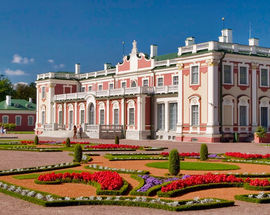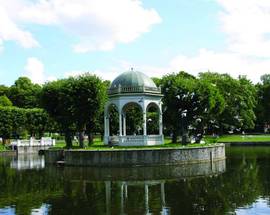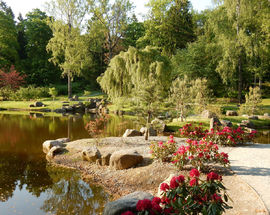The most visited spot in the park is the beautifully renovated Swan Pond, an artificial, rectangular pond with a picturesque gazebo in the middle, which looks like something out of a Chekhov play. Uphill from here you'll find another fountain area and then the Kumu art museum. Many of the palace's auxiliary buildings are also nearby. The kitchen building, opposite the palace gates, houses the Mikkel Museum.
The Youth Park, a children's playground, was first built in 1936-37 by the State Parks Agency and headed by Peeter Päts, brother of the Head of State Konstantin Päts. Innovative for its time, it was a place where children could swim and play and learn. Though many of the original outbuildings and pools have been demolished over the years, the main building was renovated in 2009 and now houses the interactive children's museum Miiamilla.
When the park was first established, one of the first projects was the construction of the Lower Garden and the canals in front of the palace. This complex area of the park was a maze of avenues, paths, gazebos, hedges and flower beds. After the death of Peter the Great in 1725, the work slowed down and the Lower Garden eventually grew into a semi-wild parkland. In 2012, the canal around the garden was rebuilt and the walkways by the channel were renovated in 2013-14.
The Upper Garden, in contrast, is a sort of extension of the interior of the palace to the outdoors. The great doors of the main hall led directly into the ornate garden. The oak tree, planted by King Gustav V during his visit in 1929 can still be seen in the Upper Garden. The current Baroque flower garden was restored according to 18th century drawings. Unfortunately the Mirage Pond, once located on the upper terrace was filled in the late 1930s during the construction of the President's administrative building. A rosarium now sits in its place.
Rose Hill boasts 32 varieties of over 6000 roses. The roses have been picked to bloom twice a year and last until the first frost. It is the largest rosarium in Estonia.







Comments